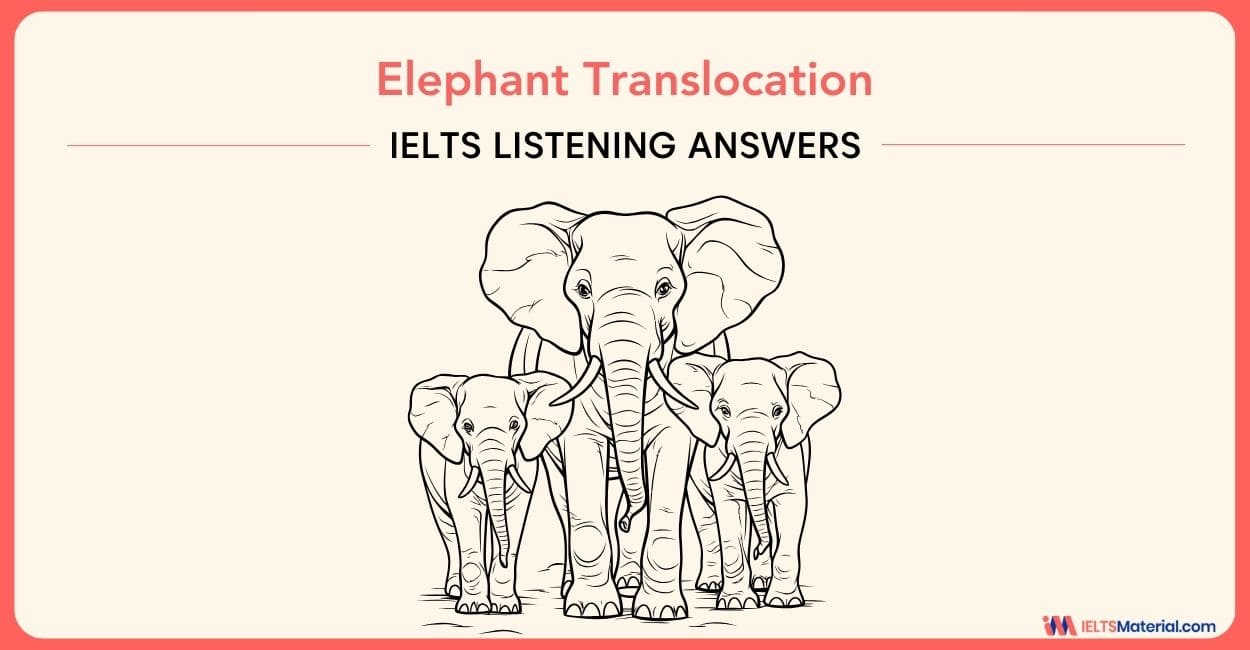Elephant Translocation - IELTS Listening Answers
4 min read
Updated On
-
Copy link
Crack the Elephant Translocation IELTS Listening test now to boost preparations for band 9 on your final test! You can also explore strategies to tackle these question types and check your answers with the help of our transcript.
Table of Contents

Limited-Time Offer : Access a FREE 10-Day IELTS Study Plan!
The ‘Elephant Translocation’ is a section in the IELTS Listening test and taking this test will familiarize you with the different tones and intonations. Moreover, this IELTS Listening Sentence Completion makes it ideal for practice. This page contains the ‘Elephant Translocation – IELTS Listening test’ for you to practice and prepare yourself to rock your final IELTS exam!
Since IELTS Listening is considered the easiest module of the exam, try to solve and review the ‘Elephant Translocation’ test to ensure that your listening skills are up to the mark now! Also, familiarize yourself with signposting and distractor techniques by trying our IELTS listening practice tests.
Listen to the Audio of Elephant Translocation - IELTS Listening Answers to Solve the Questions below.
There are 10 questions in the Listening Answers of Elephant Translocation, which includes one of the question types that is common in such tests. It is:
- IELTS Note Completion (Q. 1-10)
Get access to exclusive study material in the Comprehensive IELTS Listening Test Guide and fast-track your preparation for the IELTS Listening exam!
Questions 1-10
Complete the notes below. Write ONE WORD ONLY for each answer.
Elephant Translocation
Reasons for overpopulation at Majete National Park
- strict enforcement of anti-poaching laws
- successful breeding
Problems caused by elephant overpopulation
- greater competition, causing hunger for elephants
- damage to 1 ………………… in the park
The translocation process
- a suitable group of elephants from the same 2 ………………… was selected
- vets and park staff made use of 3 ………………… to help guide the elephants into an open plain
- elephants were immobilised with tranquilisers
– this process had to be completed quickly to reduce 4 …………………
– elephants had to be turned on their 5 ………………… to avoid damage to their lungs
– elephants’ 6 ………………… had to be monitored constantly
– tracking devices were fitted to the matriarchs
– data including the size of their tusks and 7 ………………… was taken
- elephants were taken by truck to their new reserve
Advantages of translocation at Nkhotakota Wildlife Park
- 8 ………………… opportunities
- a reduction in the number of poachers and 9 …………………
- an example of conservation that other parks can follow
- an increase in 10 ………………… as a contributor to GDP
Check Out – 1200 Commonly Repeated Words – IELTS Listening Spelling List for a Top Score
Transcript of the Elephant Translocation IELTS Listening Answers Audio
To explore further, you can download the Elephant Translocation PDF Transcript, where we’ve included answer locations.
Elephant Translocation IELTS Listening Answer Key
Access valuable insights from top IELTS experts in our free webinars—reserve your spot now!
Answers to ‘Elephant Translocation’ with Explanation
1 Answer: fences
Question Type: Note Completion
Answer Explanation: From the audio, we learn that the elephants roam out of the forest in search of food and, in the process, knock down fences around the park. Hence, the answer is ‘fences’.
2 Answer: family
Question Type: Note Completion
Answer Explanation: In practice, a group of elephants between eight and twenty in age, all belonging to one family, are moved during the translocation process. Hence, the answer is ‘family’.
3 Answer: helicopters
Question Type: Note Completion
Answer Explanation: A team of vets and park rangers fly over the park in helicopters and direct the group of elephants to a designated open plain. Hence, the answer is ‘helicopters’.
4 Answer: stress
Question Type: Note Completion
Answer Explanation: The process of immobilizing the elephants by tranquilizers has to be done quickly in order to reduce stress. Hence, the answer is ‘stress’.
5 Answer: sides
Question Type: Note Completion
Answer Explanation: When the elephants are tranquilised, they are turned to their sides as if they lie on their chest, there is a risk of suffocation and lung damage. Hence, the answer is ‘sides’.
6 Answer: breathing
Question Type: Note Completion
Answer Explanation: Due to the process of tranquilization, it is essential to check the breathing of the elephant, which should be fewer than six breaths per minute. Hence, the answer is ‘breathing’.
7 Answer: feet
Question Type: Note Completion
Answer Explanation: The measurements of their tusks and their feet are taken. Hence, the answer is ‘feet’.
8 Answer: employment
Question Type: Note Completion
Answer Explanation: As the elephants translocated to Nkhotakota, the employment opportunities have increased, which has positively affected the community. Hence, the answer is ‘employment’.
9 Answer: weapons
Question Type: Note Completion
Answer Explanation: The second benefit of the translocation process is that many people from the community gave up their weapons as they had employment and did not require poaching the tusks. Hence, the answer is ‘weapons’.
10 Answer: tourism
Question Type: Note Completion
Answer Explanation: The most important benefit of translocation is that it attracts tourism, which contributes to five times more than the illegal wildlife trade. Hence, the answer is ‘tourism’.
3 Tricks to Crack IELTS Listening ‘Elephant Translocation’ Note Completion
- Try focusing on synonyms and paraphrasing since the speaker may not be using the exact words in your question.
- Try noting down the important points (in your question paper) and if possible your answers (in your answer sheet) as you listen. You do not have to wait until the audio ends to write the answers.
- Skimming the questions before the audio plays always helps to predict answers and know what to listen for.
Enhance Your IELTS Listening Skills Stand Out with IELTSMaterial
Boosting your listening skills isn't just about listening to the conversation. It's also about grasping the information clearly and having to reply back with good grammar. Doing this all alone by practising test papers might be hard. So, you can get help from our IELTS experts or attend our FREE webinars to learn tips and improve your listening skills for the IELTS exam!
Practice now:

Start Preparing for IELTS: Get Your 10-Day Study Plan Today!
Explore other Listening Practice Tests

Kasturika Samanta

Prity Mallick

Kasturika Samanta
Recent Articles

Kasturika Samanta

Prity Mallick

Haniya Yashfeen

Kasturika Samanta





Post your Comments